Low Light Succulents are highly adaptable and some can still thrive. If you are growing succulents and your lighting conditions are less than ideal, some succulents can tolerate low light.
Here I will tell you all about them they are perfect to have indoors, wheater that be the offices, house even if you work on a Cruise, it will survive. You will love it.
You may like Succulents that Hang Down
Aloe Vera
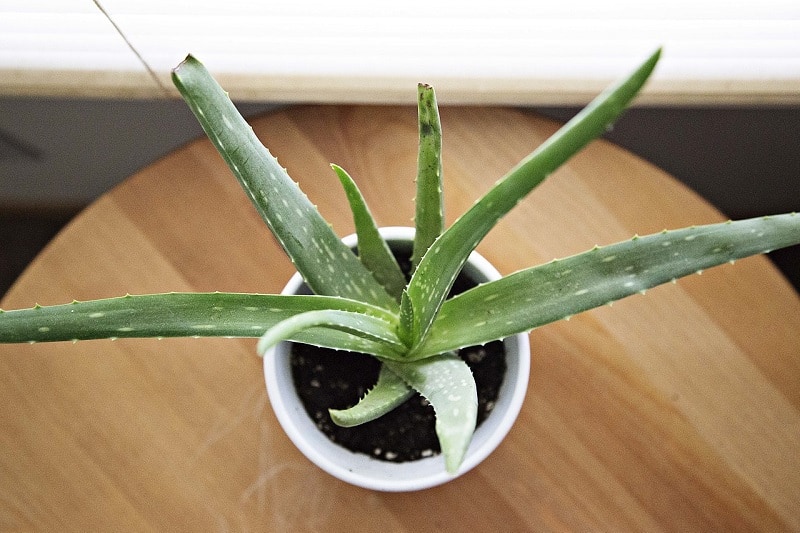
The aloe vera plant is an easy Low Light Succulents, attractive succulent that makes for a great indoor companion.
Aloe vera plants are useful, too, as the juice from their leaves can be used to relieve pain from scrapes and burns when applied topically.
Here’s how to grow and care for aloe vera plants in your home!
Aloe vera is a succulent plant species of the genus Aloe.
The plant is stemless or very short-stemmed with thick, greenish, fleshy leaves that fan out from the plant’s central stem.
The margin of the leaf is serrated with small teeth.
Before you buy an aloe, note that you’ll need a location that offers bright, indirect sunlight (or, artificial sunlight).
However, the plant doesn’t appreciate sustained direct sunlight, as this tends to dry out the plant too much and turn its leaves yellow.
Keep the aloe vera plant in a pot near a kitchen window for periodic use but avoid having the sun’s rays hit it directly.
Please note: The gel from aloe vera leaves can be used topically, but should not be ingested by people or pets.
It can cause unpleasant symptoms such as nausea or indigestion and may even be toxic in larger quantities.
4 Benefits of using the aloe vera:
1.Contains healthful plant compounds
Aloe vera is a thick, short-stemmed plant that stores water in its leaves.
It is widely used in the cosmetic, pharmaceutical and food industries, and has an estimated annual market value of $13 billion globally.
Aloe vera is well recognized by its thick, pointed, and fleshy green leaves, which can grow to about 12-19 inches (30-50 cm) in length.
Each leaf is full of a slimy tissue that stores water, which makes the leaves thick.
This slimy, water-filled tissue is the “gel” we associate with Aloe vera products.
The gel contains most of the bioactive compounds in the plant, including vitamins, minerals, amino acids, and antioxidants.
2.Antioxidant and antibacterial properties
Antioxidants are important for health.
Aloe vera gel contains powerful antioxidants, which belong to a large family of substances known as polyphenols .
These polyphenols, along with several other compounds in Aloe vera, can help inhibit the growth of certain bacteria that can cause infections in humans.
3.Accelerates the healing of burns
Aloe vera is most commonly used as a topical medication, rubbed onto the skin rather than eaten.
It has long been known as a treatment for sores, particularly burns, including sunburns.
In fact, the FDA first approved Aloe vera ointment as an over-the-counter medication for skin burns back in 1959.
Studies suggest that it is an effective topical treatment for first- and second-degree burns.
A review of 4 experimental studies found that Aloe vera could reduce the healing time of burns by around 9 days compared to conventional medication .
4.Reduces dental plaque
Tooth decay and diseases of the gum are very common health problems.
One of the best ways to prevent this from happening is to reduce the buildup of plaque (bacterial biofilms) on the teeth.
In a mouth rinse study of 300 healthy people, 100% pure Aloe vera juice was compared to the standard mouthwash ingredient chlorhexidine.
After 4 days of use, the Aloe vera mouth rinse was found to be just as effective as chlorhexidine in reducing dental plaque .
Gasteria Succulent
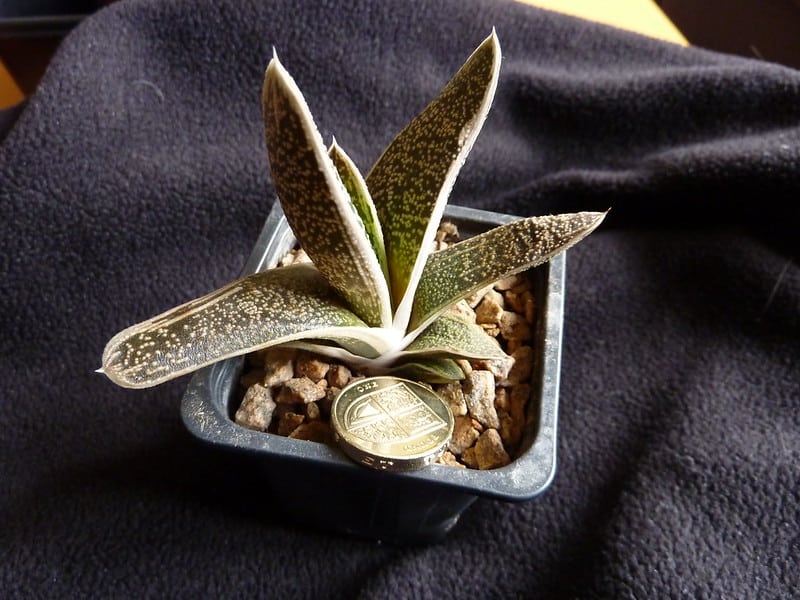
Gasteria is a genus of relatively rare, aloe-like succulents. This Low Light Succulents sometimes goes by the colloquial name “ox tongue,” after the long, rough texture of the leaves.
The plant is named for the sac-like shape of its flowers, which are supposed to resemble a stomach.
The genus is native to South Africa, where it grows in lightly shaded conditions with excellent drainage.
As a result, the plant tolerates lower light conditions than most other well-known succulents, making them very good houseplants.
Depending on the species, gasteria leaves are often marked with interesting patterns and coloration. The G. verrucosa species also have wart-like protrusions on its leaves.
- Botanical Name: Gasteria spp.
- Common Name: Gasteria, ox-tongue, cow’s tongue, lawyer’s tongue
- Plant Type: Perennial succulent
- Mature Size: Arching, a sprawling habit with leaves from 1 inch to 3 feet in length, depending on species
- Sun Exposure: Bright, filtered light; out of direct sunlight
- Soil Type: Well-drained, somewhat sandy soil, but high in organic material
- Soil pH: 6.0 to 7.0; slightly acidic to neutral
- Bloom Time: Varies widely, depending on species; usually spring and summer
- Flower color: Varies with species; usually pinkish or reddish
- Hardiness Zones: 9 to 11
- Native Area: South Africa
Indoors, potted gasteria should be planted in bright light but not direct sunlight.
Indoors gardeners find they do well in cool rooms with limited sunlight.
Gasteria, like most succulents, requires little water or fertilizer.
Feed them once a year in the spring (both indoor plants and those in the garden).
Indoor potted plants can be brought outdoors and placed in lightly shaded areas for the summer.
When planted in the garden, the ideal soil will be somewhat sandy and well-drained, which will prevent root rot.
Choose a bright but shady spot; dappled sunlight beneath large trees is ideal.
They do not react well to water falling directly on the leaves, so you may want to provide shelter for them.
Haworthia margaritifera, Pearl Plant, Zebra Cactus
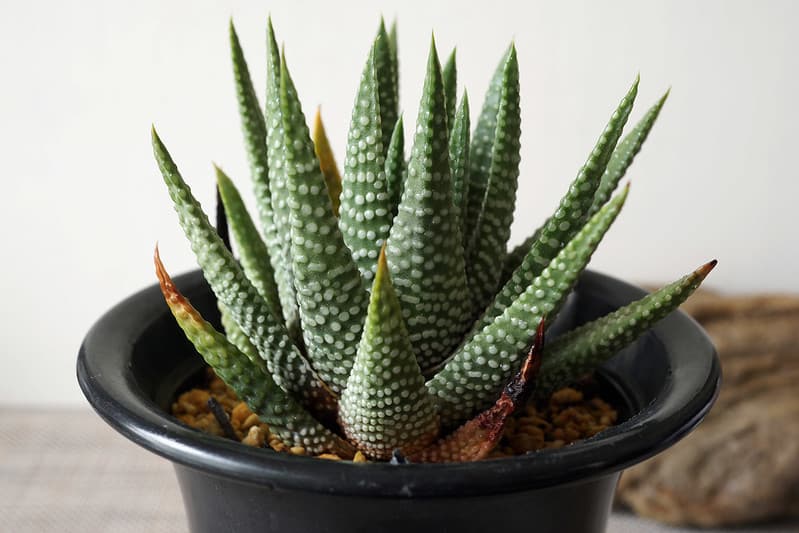
Haworthia is a delightful little Low Light Succulents that makes a very attractive small houseplant.
These small, low growing plants form rosettes of fleshy green leaves that are generously covered with white, pearly warts or bands, giving them a distinctive appearance.
Generally easy to grow, the same best practices that yield healthy aloe and echeveria plants will also produce beautiful Haworthia.
Like other succulents, these plants appreciate bright light, adequate moisture in the summer, and relatively drier conditions in the winter. Avoid overwatering, but don’t let them dry out too much.
Botanical Name Haworthia
Common Name Zebra cactus, pearl plant, star window plant, cushion aloe
Plant Type Succulent
Mature Size Varies by species, 3 to 5 inches, up to 20 inches
Sun Exposure Part sun
Soil Type Sandy
Soil pH 6.6 to 7.5
Bloom Time Summer
Flower Color White
Hardiness Zones 11
Native Area Southern Africa
Echeverias succulents
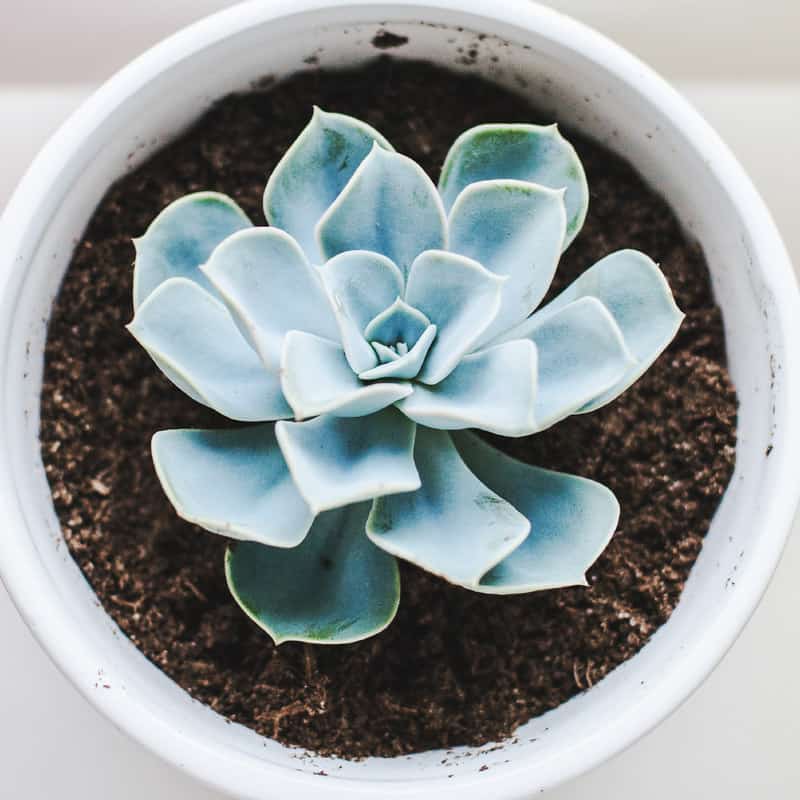
Echeveria spp. stem from thick-leaved rosettes. The leaves are fleshy and have a waxy cuticle on the exterior.
Often the leaves are colored and a firm touch can mar the skin and leave marks. The Echeveria succulent plant is slow growing and usually doesn’t exceed 12 inches (30 cm.) in height or spread.
Native from Texas to Central America, the plants prefer desert conditions, but will tolerate periods of moisture as long as they are allowed to dry out before applying more water.
Growing Echeveria in an unglazed clay pot, which will allow water to evaporate, is ideal.
Otherwise, they need full sun and well drained soil. There are 150 cultivated varieties of the plants, one of which is probably right for you.
These easy little succulents produce offsets or baby plants nestled against the mother rosette.
These are easy to separate and grow. Just pull the little rosette away and replant in a cactus mixture or homemade blend of equal parts sand, topsoil and compost.
You can also start new plants from leaf cuttings. Simply lay the leaf on the surface of the soil. It will root within a few weeks and soon a small rosette will grow next to the rooted leaf.
The leaf will dry up and crumble off of the new plant.
Rhipsalis Species, Mistletoe Cactus
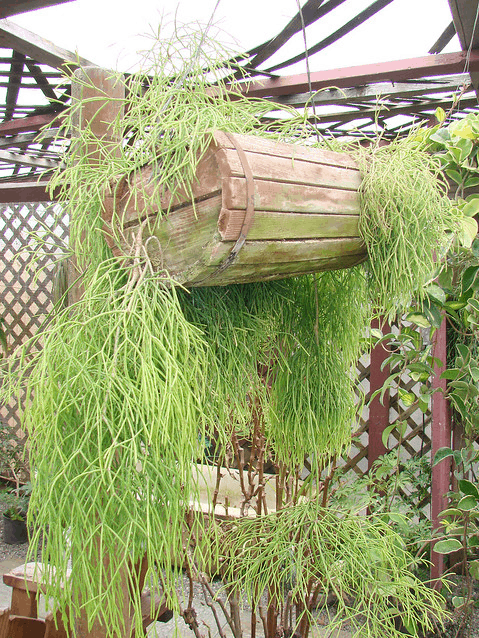
Mistletoe cactus (Rhipsalis baccifera) is a tropical Low Light Succulents native to rainforests in warm regions.
The grownup name for this cactus is Rhipsalis mistletoe cactus. This cactus is found in Florida, Mexico and Brazil.
Surprisingly, growing Rhipsalis requires shade to partial shade. While most cacti are found in hot, sunny, arid zones, mistletoe cactus is unique in its requirements for moisture and dim light.
Take some tips on how to grow mistletoe cactus and enjoy this unique and entertaining looking plant.
The edible fruits are gathered from the wild for local consumption. The plant is often grown as an ornamental.
Found at low to moderate elevations in the moist tropics.
Plants are not tolerant of frost.
Prefers a position in light to moderate shade.
Requires a well-drained soil.
Requires a pH below 6.
Plants can flower and produce fruit all year round.
The fruit is produced in great profusion.
Schlumbergera, Holiday Cacti
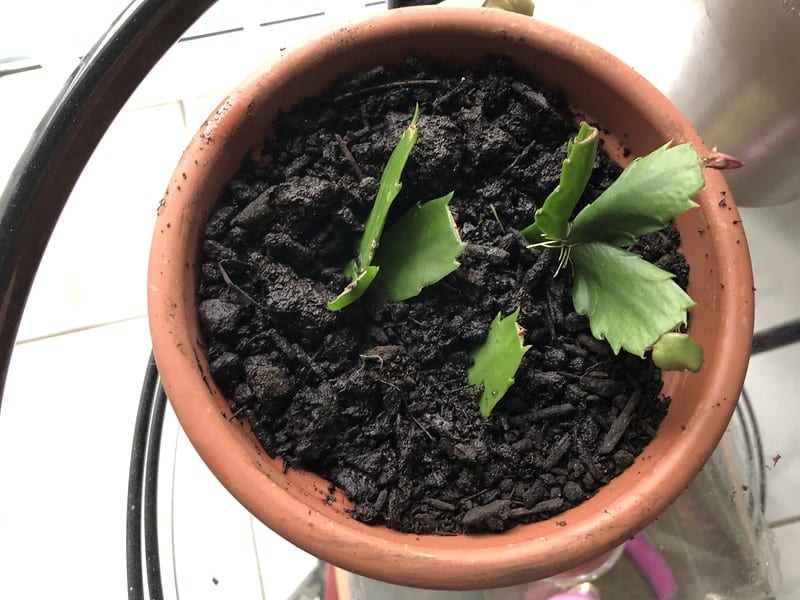
Thanksgiving cactus (Schlumbergera truncata), Christmas cactus (Schlumbergera bridgesii) and Easter cactus (Schlumbergera gaertneri) are popular houseplants,Low Light Succulents, often given as gifts during the holiday season.
They are grown for their beautiful, exotic flowers.
Holiday cacti can be very long-lived. It is possible for these plants live over 100 years, passed down from generation to generation.
Although true cacti, these plants are native to rainforests.
The need for high humidity, bright but filtered light, and soil kept relatively moist most of the year sets these plants apart from the majority of cacti and succulents.
People often complain about the lack of flower blooms. It is important to understand how light, temperature, and overall plant health affects blooming.
Though called Thanksgiving, Christmas and Easter cactus, these common names are only a general reference for the time of year these plants may bloom.
Kalanchoe blossfeldiana, Flaming Katy
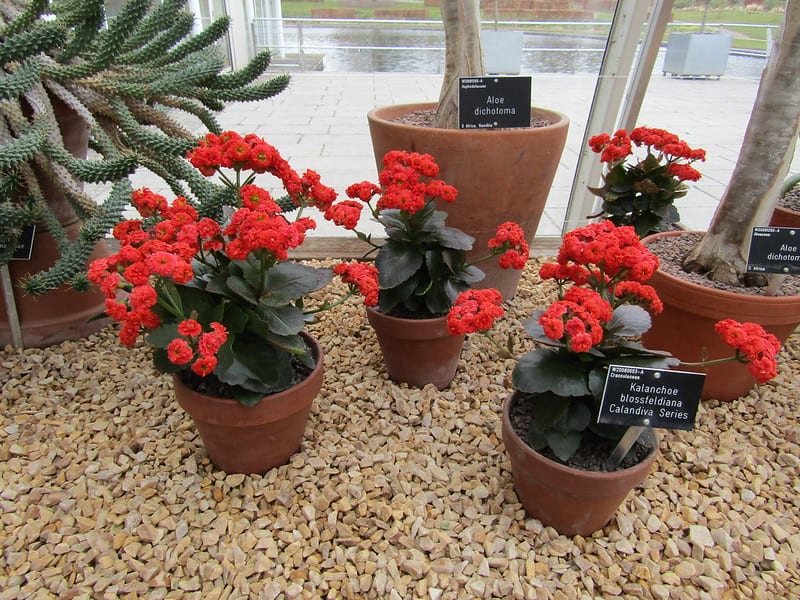
By the time the leaves change and the first storms of winter approach, the intrepid gardener is itching for some living green thing to nurture and bring color to the home.
Flaming katy kalanchoe is Low Light Succulents ideal plant to chase away the winter doldrums. In most zones the plant is used as an interior plant, but growing flaming katy outdoors is possible in the warmer climates.
The shiny green, scalloped leaves and brilliant flowers enliven any situation and care for flaming katy is a breeze.
Discover how to grow flaming katy plants and charge up your interior with some vibrant tones and unique foliage.
Flaming katy is grouped with the succulent variety of plants. This lovely specimen is often found in the gift floral section of your local supermarket or big box nursery, but don’t let its availability fool you. Flaming katy houseplant is a spectacle to behold, especially if you are starved for color and a new plant buddy.
The leaves are thick and waxy like a jade plant but have a sculpted edge. Plants get about 12 inches high and just a little smaller in width. The flowers are a real show stopper in bright colors like pink, yellow, orange and red.
The plants require well-drained soil and prefer drier conditions. Flaming katy houseplants that get overwatered will show their displeasure with yellowing, dropping leaves and rotten stems.
Hoya obovata, Wax Plant
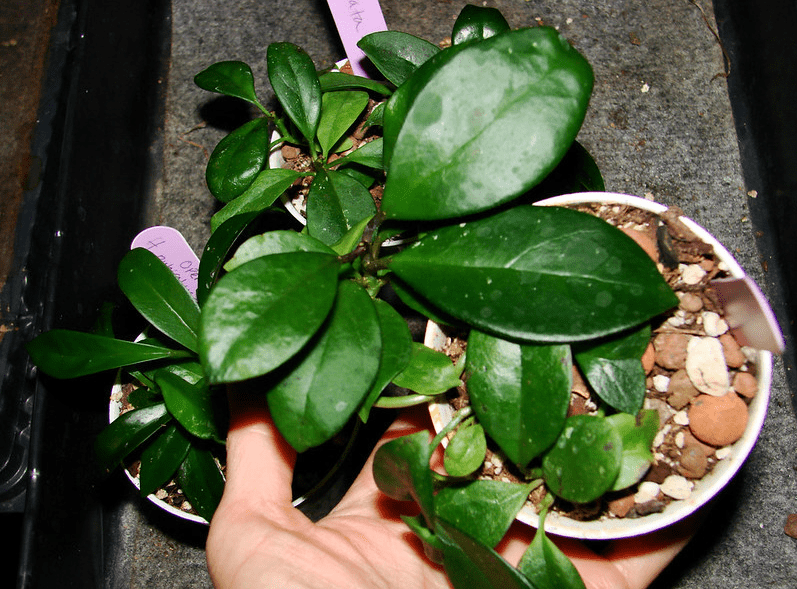
Hoyas are commonly used as Low Light Succulents for indoors (sitting on a table, shelf, buffet, credenza, etc) or as hanging plants.
They’re sold in 4, 6, 8, & 10″ grow pots; usually with a hanger. My Hoya carnosa variegata which grows outdoors has 4-5′ trails. In their natural environment, many grow as climbing vines.
There are many species & varieties of Hoyas sold on the market. You can find at least 1 that catches your fancy because the foliage comes in a variety of shapes, sizes, colors & textures.
The ones I’ve seen most often are H. carnosa, H. carnosa variegata, H. carnosa compacta , H. Kerrii, & H. obovata.
Sansevieria (Snake Plant)
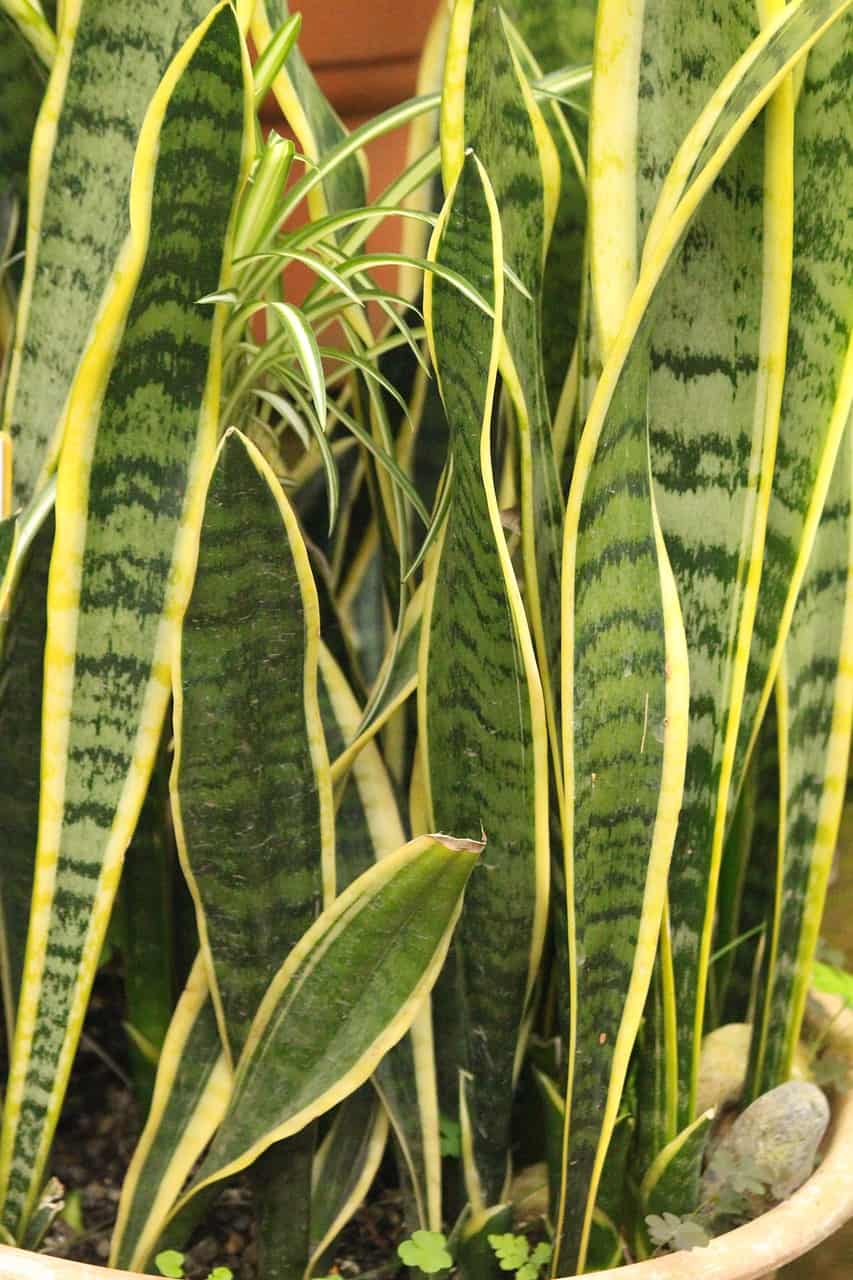
Sansevierias (Snake Plants) are some of the toughest plants you can find. Whether indoors, in your garden or on your balcony, these spiky beauties can put up with almost anything.
They’re easy to grow, but there are a few things you should know. Keep reading for Snake Plant care as a houseplant – you’ll see how low maintenance they really are.
These plants aren’t favored by everyone because of their strong, bold look and tough, pointed leaves.
They’re definitely not the soft, “touchy-feely” kind of plants but they certainly have character and present quite the silhouette.
These evergreen perennials are very long-lived, unlike some houseplants.
If you’re looking for your own Snake Plant, there are many different species and varieties on the market with more being introduced each year.
You can find them tall or short, with round, flat or concave leaves, and variegated with dark green, silver, light green, yellow, chartreuse, or white.
My personal favorites are the old standbys Sansevieria trifasciata and “laurentii“, cylindrica (this is the 1 they braid), “moonshine“, “futura superba” and “gold hahnii“.
Parodia Haselbergii (Scarlet Ball Cactus)
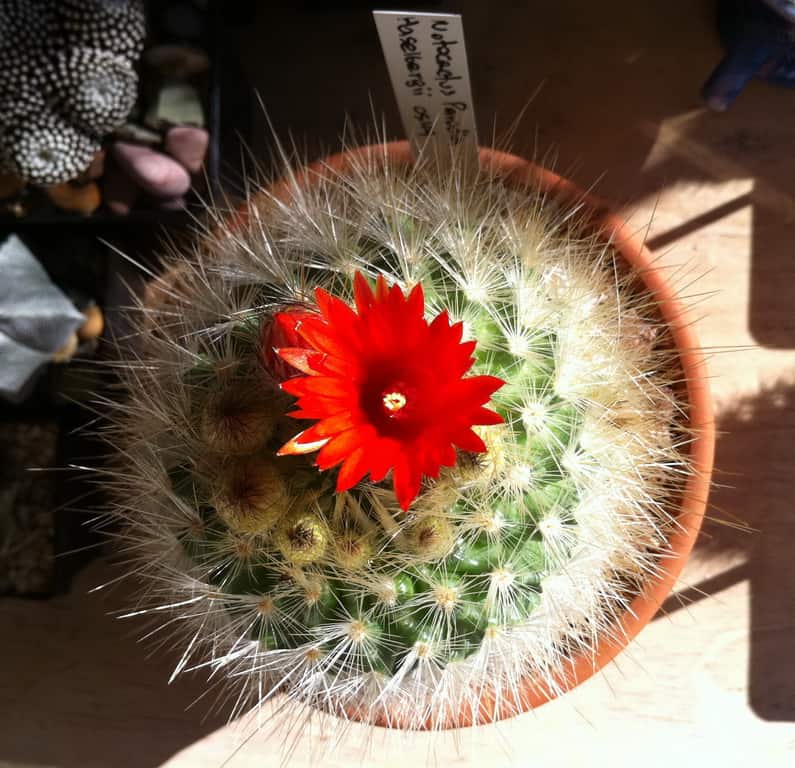
The Parodia genus includes a multitude of showy and easy-to-grow small ball cacti.
After a reorganization of the genus, the Parodia genus now includes plants that were formerly known as Notocactus, Eriocactus, and Brasilicactus.
Parodia is native to central South America, where they enjoy somewhat more moisture than most people associate with cacti.
They are also not full-sun plants, but especially during the summer months of strong sun they appreciate some daytime shade.
Older plants will frequently produce flowers in yellow, red, orange, or pink, depending on the species. Overall, these are easy and excellent beginning cacti.
Growing Conditions
Light: Parodia typically doesn’t like direct afternoon sunlight and should be in partial shade through the hottest hours.
They can take direct sunlight in the morning and afternoons.
Water: Throughout the growing season (spring and summer) provide regular water to keep the potting soil lightly moist.
In the winter, cut back watering and let the soil almost dry between waterings, but do not let it completely dry out.
Soil: A rich, fast-draining cactus mix is ideal.
Fertilizer: During the growing season, fertilize with a cacti fertilizer mix. These respond especially well to fertilizer. Suspend feeding during the dormant winter period.
Propagation
Parodia cacti can be propagated easily from offsets, which readily form in clusters around the base of the mother plant.
To propagate, carefully remove the offset and allow the cut section to dry on a paper towel for a few days. Depending on the size of the cut area, a callous will form over the cut surface.
Once the callous has formed, place the new plant in a pot with a potting soil mixture and keep in a warm place until new roots emerge. Once the plant is established, repot it into a regular container.
Parodia is also relatively easy to grow from seeds. Once the sprouts have emerged, keep them regularly moist for the few months and be prepared to wait: some of the more common Parodia species can take a long time to grow to a decent size.
Repotting
Repot as needed, preferably during the warm season.
To repot a cacti, make sure the soil is dry before repotting, then gently remove the pot. Knock away the old soil from the roots, making sure to remove any rotted or dead roots in the process.
Treat any cuts with a fungicide. Place the plant in its new pot and backfill with potting soil, spreading the roots out as you repot. Leave the plant dry for a week or so, then begin to water lightly to reduce the risk of root rot.
Beaucarnea Recurvata (Ponytail Palm Tree)
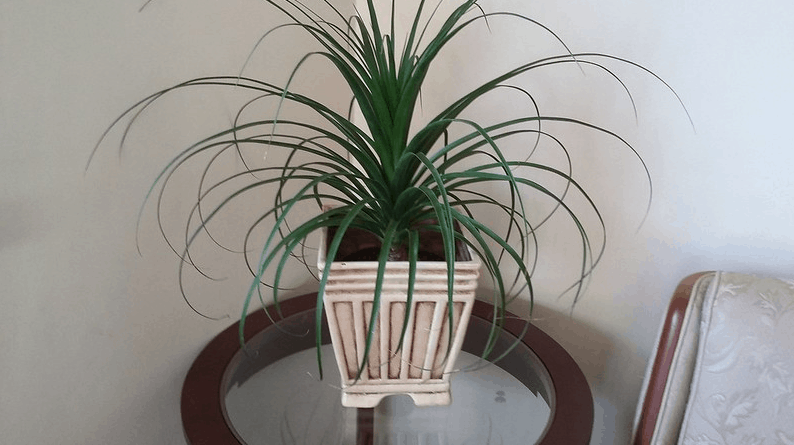
Ponytail palm is a plant with a confused identity. Not a true palm (the family Arecaceae), it is one of seven species in the genus Beaucarnea or Nolina.
The group has been included in the Nolinaceae, Agavaceae, and Ruscaceae. Regardless of its taxonomic designation, this group of small tropical trees is native to Mexico, Belize and Guatemala.
Ponytail palm, Beaucarnea recurvata (or Nolina recurvata) from semi-desert areas of southeastern Mexico, is the species often grown as a low-maintenance houseplant in temperate climates, as well as being used as a landscape specimen in dry, warm climates (zones 9-10). This succulent is often mistakenly called a palm because of its single trunk with leaves at the top.
Other common names include Bottle Palm and Elephant’s Foot Tree.
Rebutia “Crown Cactus”
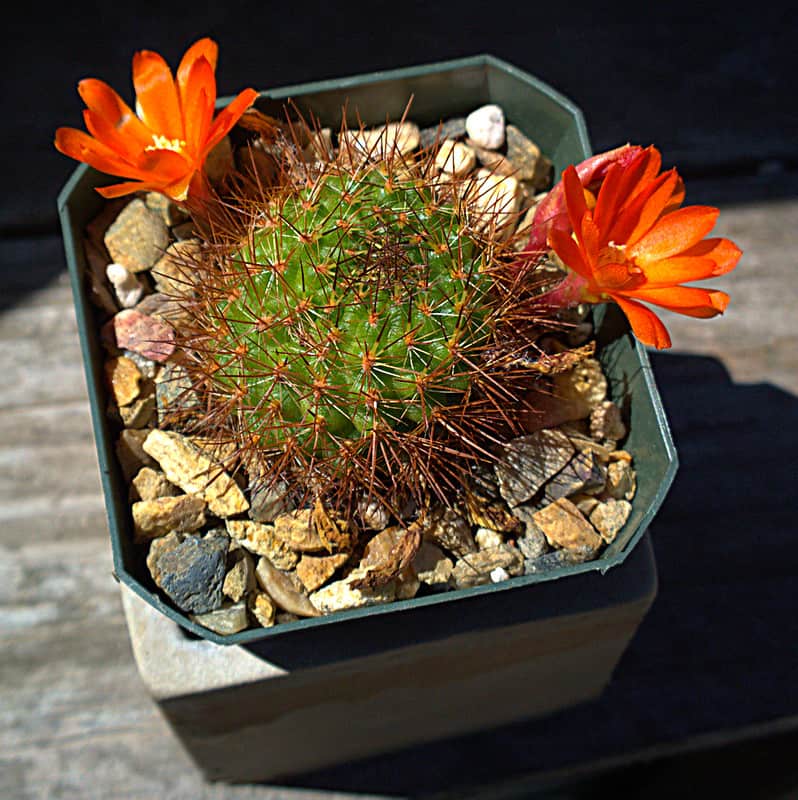
Commonly called crown cacti, the Rebutia genus includes some of the most popular and easiest to grow cacti, making them perfect for beginners.
These plants are native to high elevations in South America, where they grow in clusters on the mountains.
They are frequent bloomers and readily send out offshoots, so even plants only two or three years old will form an attractive cluster of small plants.
Their flowers typically emerge from the base of the plant or between individual plants in the same cluster, as opposed to the crown of the plant. In terms of culture, they are not particularly difficult and like bright light and light moisture.
Growing Conditions
- Light: Rebutia thrives in bright light and range of conditions. Many species can be grown in partial shade to full sun. However, as these are mountain species, they do not appreciate high temperatures, which should be avoided.
- Water: Throughout the growing season (spring and summer) let the potting soil almost completely dry out between waterings, then water thoroughly. In winter, cut back watering.
- Soil: A rich, fast-draining cactus mix is ideal.
- Fertilizer: During the growing season, fertilize with a cacti fertilizer mix. Suspend feeding during the dormant winter period.
Cotyledon Tomentosa “Bear Paws”
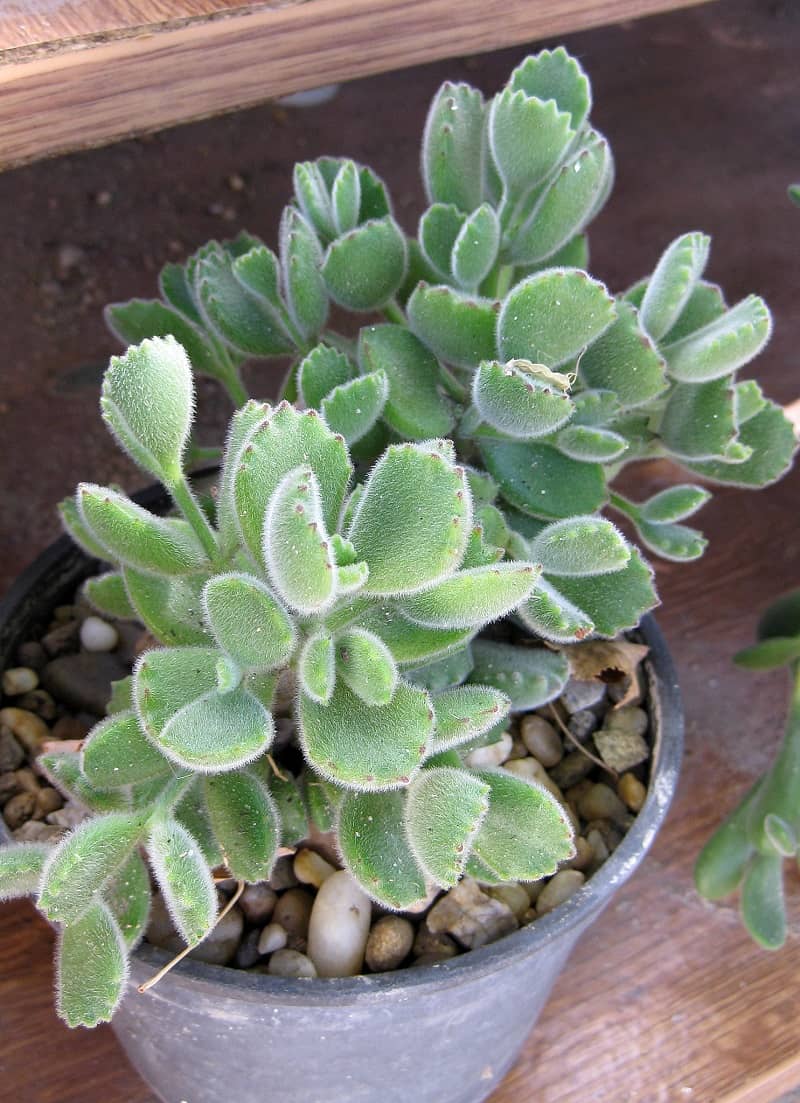
This Low Light Succulents is one of the most beautiful and rare plants we can find is the bear paw succulent.
Or as other formal name Cotyledon Tomentosa
The Bear Paw succulent is a small succulent plant belonging to the Crassulaceae family.
It is native to South Africa, but thanks to its appeal, it is cultivated in much of the world.
The Cotyledon Tomentosa succulent is grown mainly in pots since it fails to reach large dimensions and has fairly slow growth.
This succulent is a species that is characterized by developing branched cylindrical stems that fail to exceed 20 cm in height.
The branches originate directly from the leaf axils, forming very dense plants.
The shape of the leaves is rounded to spatulated with the entire lateral margins and the end clearly jagged.
The dentition of the margin in combination with the shape of the leaf closely resembles the claw of a bear.
All the leaves have a very attractive light green coloration.
Both the leaves and the stems have the surface covered by a layer of small whitish filaments, which makes the leaves soft to the touch.
The flowers are small, but they provide extra ornamental value to the plant.
They are arranged in small inflorescences that originate from the apex of the stems.
They all have a flared shape with orange-reddish petals. They bloom from mid-spring to almost late summer.
This succulent is often used for potting, but they are suitable for rockery, slopes and cactus succulent gardens.
They can also be used as houseplants but located in a place with good ventilation.
Sedum morganianum, Burro’s Tail
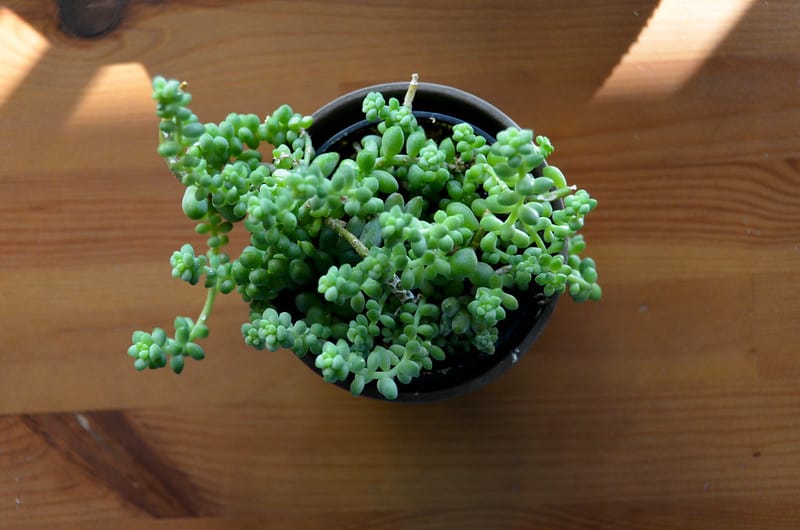
Burro’s tail cactus (Sedum morganianum) is not technically a cactus but a succulent.
Although all cacti are succulents, not all succulents are cactus. Both do have similar requirements such as gritty soil, good drainage, sunshine and protection from extreme cold temperatures.
Growing burro’s tail provides fascinating texture as a graceful houseplant or lush green exterior plant in many landscape situations.
Burro’s tail is a heat and drought tolerant plant well suited for warm to temperate regions.
The thick stems appear woven or plaited with leaves.
The succulent is green to gray green or even blue green and may have a slight chalky look. Try a burro’s tail houseplant or use it on the patio or full sun garden bed.
The succulent thrives indoors in a well-drained container where bright sunlight bathes the plant.
A burro’s tail houseplant will grow equally well in a mixed succulent container or as a hanging specimen.
Slowly introduce the plant to full sun once purchased to allow it to acclimate first, as light conditions vary from nursery to nursery, etc.
Sempervivum tectorum – Common Houseleek, Hens and Chicks
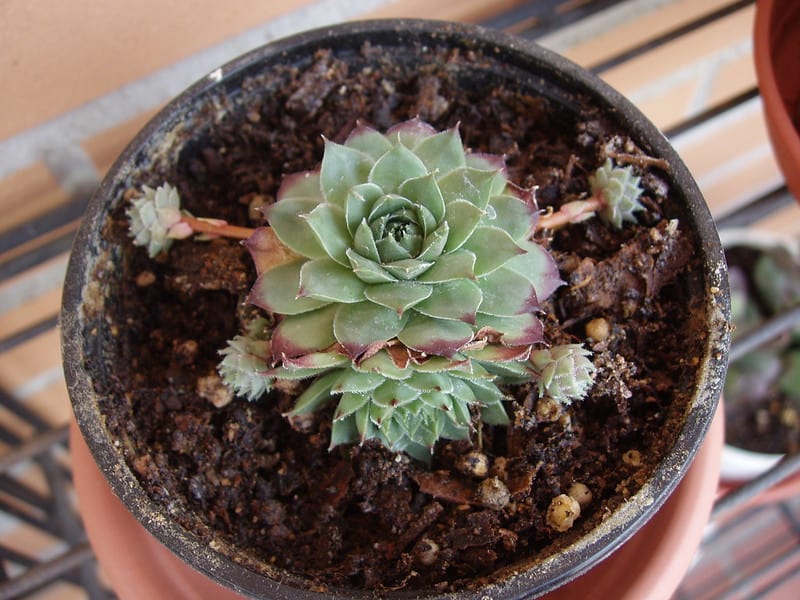
Hens and Chicks (Sempervivum tectorum) are Low Light Succulents evergreen succulent plants that look a little like rubbery roses.
They are considered alpine or rock garden plants, because of their hardiness and drought resistance.
The original rosette, the ‘Hen’ produces tiny rosette offsets that are known as the ‘Chicks.’
The name Sempervivium is Latin for “live forever.” They don’t really live forever, but since they produce so many ‘chicks’ or plantlets, they seem to last forever.
Plus, they remain evergreen throughout the year, even in cold climates. Hens and Chicks are also tough, drought-resistant plants.
- Leaves: Thick, fleshy pads arranged in 3 to 4-inch rosettes. The leaves are usually pointed, and some have purple tips. There are varieties with green leaves and shades of red.
- Flowers: Mature plants produce an odd-looking thick flower stalk with star-shaped flowers at the tip of mauve-pink or red. The flower stalk extends 8 to 12 inches before blooming. Once the plant blooms, the mother plant dies.
Aloe variegata (Partridge Breast Aloe)
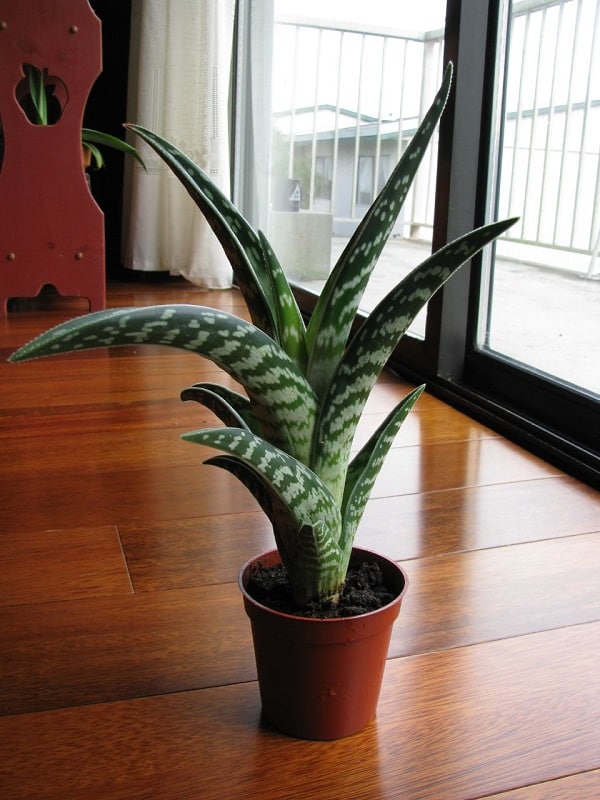
Aloe variegata (Partridge Breast Aloe) is a Low Light Succulents.This smaller aloe grows to 10 to 12 inches tall to 9 inches wide and forms rosettes, sometimes solitary but often clustered, with leaves arranged in 3 ranks that are upright with a boat-hull shape (lanceolata-deltoid) that have a distinct gutter down the middle.
The leaf margins have tiny blunt white teeth along the entire length and are a white color that stands out well against the dark green color of the leaf, which also has short longitudinally-arranged white spots on upper and lower surfaces that often line up in horizontal bands, giving this plant the common name of Tiger Aloe.
The spots are also said to resemble those on a partridge breast, which gives this plant its most used common name.
The plant will get red highlights that turn the deep green to a more brown color when the plant is drought stressed.
The pink to pale red flowers appear on short, stout, and sometimes branched inflorescences.
In the wild, flowering for this plant is noted as responding to rains and in Southern California most find that it flowers in mid-winter.
Plant in full coastal sun to shade in a very well-drained soil and irrigate little to occasionally.
One cannot seem to underwater this plant but many a grower (us included) will note that this plant can rot out at its base if over irrigated or if soil is not well draining; this being said, others say that they can irrigate with impunity without any problems. It is hardy to around 20 F.
This aloe is found naturally throughout arid or semi-arid regions of South Africa and in southern Namibia, often in well drained soils in the shade of shrubs or rock crevices.
Jade Plant low light (Crassula ovata)
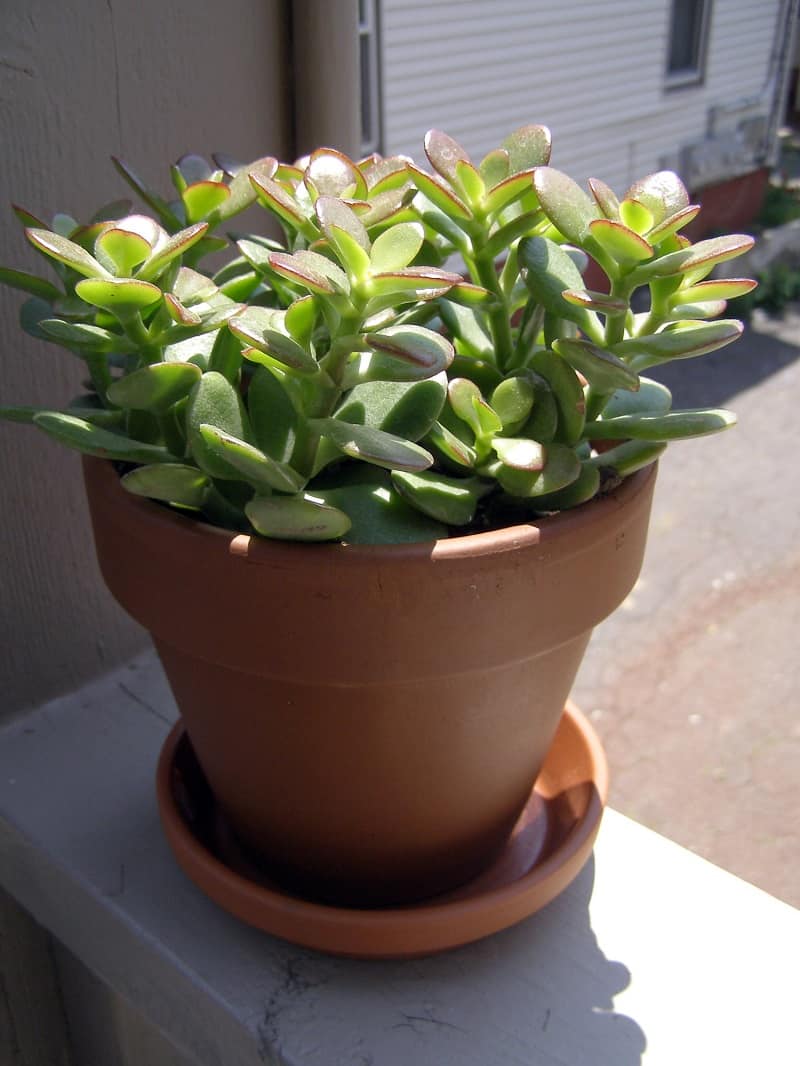
The Jade is Low Light Succulents grows indoors and borrows itself from the bonsai in the way it grows like a miniature tree, with a trunk and branches.
It is also a succulent that will retain water well within the leaves, just like the cactus plant.
This succulent is a hardy fellow and has two main requirements for a healthy long life, which is water and plenty of light.
They are both an indoor and outdoor species, although conditions outside need to be right (enough heat and sun).
As mentioned the Jade has a similar look to a bonsai tree with a thick trunk and branches.
The leaves are a thick oval shaped type which are a shiny dark green and possibly red colored outer edge’s.
They can produce white or pink flowers in the right conditions, once they have matured. The most important aspect of displaying this shrub is plenty of sunlight…..close to a window.
Euphorbia tithymaloides (Pedilanthus tithymaloides)
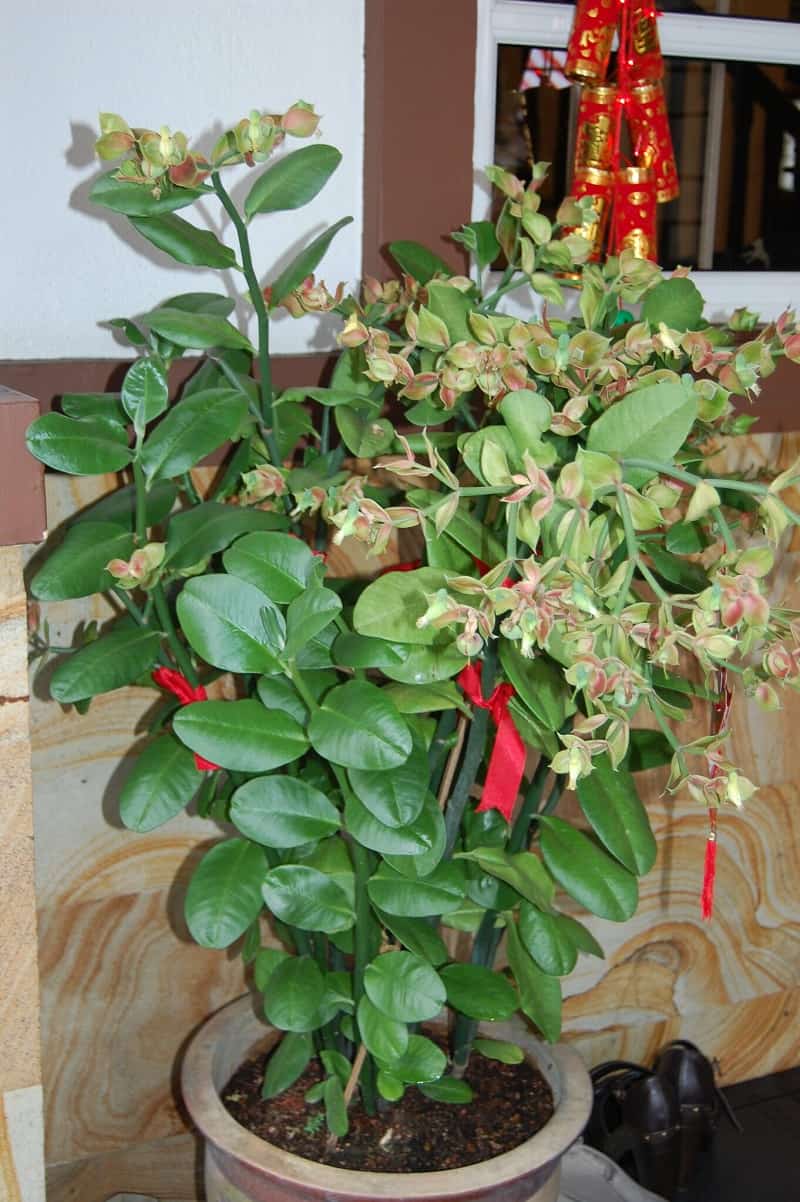
Pedilanthus tithymaloides is a Low Light Succulents commonly called devil’s backbone in reference to the zigzag stems that purportedly resemble a spinal column.
Native from southern Florida and the Caribbean to Venezuela, this clump-forming succulent shrub or subshrub will grow in nature to 6’ tall and to 3’ wide. Indoors, it more typically grows to 2’ tall.
Ovate to elliptic, medium green leaves (to 3” long). Showy, two-lipped, red bracts encase insignificant tiny scarlet flowers in late spring or early summer.
Flowers are clustered at the branch ends. Fruits are small capsules. Plants rarely bloom indoors, however. Zigzag stems exude a poisonous milky sap when cut.
Genus name comes from the Greek words pedilon meaning sandal and anthos meaning a flower for the shape of the flowers.
‘Variegatus’ has leaves with pink or white variegation.
No serious insect or disease problems. Watch for mealybugs or spider mites.
Kalanchoe tomentosa (Panda Plant)
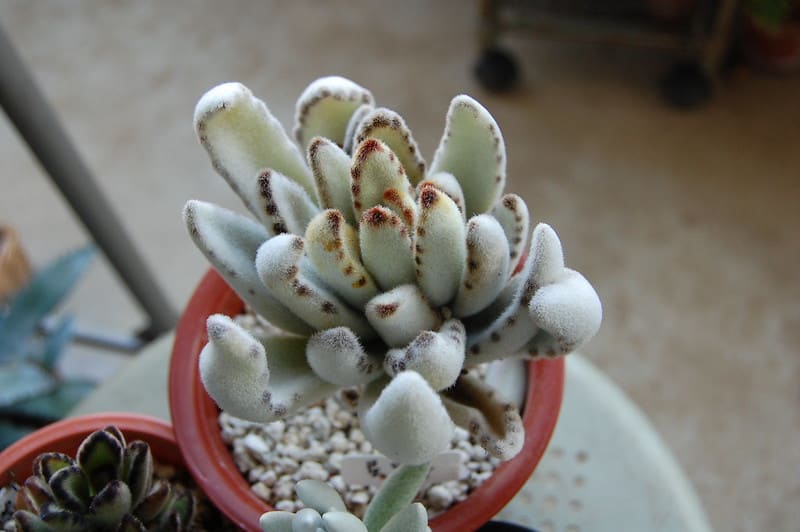
The indoor panda plant is a Low Light Succulents hardy that makes an interesting addition to the houseplants you grow indoors.
Often a favorite of children, growing Kalanchoe panda plants are a good specimen to locate in a child’s room as part of the décor.
Keep reading to answer the question of what is Kalanchoe tormentosa and how to grow a panda plant indoors.
More than 100 varieties of Kalanchoe grow in the wilds of Africa and other parts of the Old World.
Kalanchoe tomentosa grows wild on the island of Madagascar. In its native environment, growing Kalanchoe panda plants have a woody base and reach several feet.
As an indoor plant, however, panda plant growth is limited by the size of the container, usually reaching only 1 to 2 feet in height and 2 feet around.
Further information on growing Kalanchoe panda plants says the velvety appearance of the leaves is created by hairs that spring up in trichomes, deflecting light and limiting transpiration.
Brownish red markings on leaf edges, along with the white-silvery hairs, are similar to the fur of a panda bear. Tomentosa means densely woolly or velvety.
The plant is also commonly called pussy ears as well.
Locate the indoor panda plant in medium to bright light. As with most succulents, soil should be allowed to dry between waterings.
In fact, watering is a limited part of panda plant care. When you do water, do so completely while giving the plant the infrequent drink.
You’ll find humidity is not an issue when learning how to grow a panda plant successfully.
The average room provides enough humidity for this easy-care, furry plant. The indoor panda plant can live for many years in these conditions.
Move it outside during spring and summer, if desired, but provide protection from hot afternoon sun.
Fertilize during these months with a balanced houseplant food mixed at half strength as a part of panda plant care.
Kalanchoe tomentosa “Panda Plant” is a velvety, green succulent with brown spots on the tips of the leaves. It does very well indoors, and is great for beginners.
How to water low light succulents and cactus
Low Light Succulents store extra water in their leaves, stems, or roots, which gives them the ability to survive a while between waterings (sometimes a month or more).
Because they have a reputation for being drought-tolerant and growing in arid conditions, many people fail to realize that when you bring them into your home or garden, they still need to be watered regularly.
In order to keep your succulents thriving, it’s not a good idea to force them to go without water for weeks or months at a time.
No matter where you end up planting them, there are a few tips for you can follow for how often to water succulents that will save them drying out too much, and also prevent you from overwatering them.
How to Water Succulents Indoors
For Low Light Succulents rather than giving your succulents sips of water here and there, give them a good soaking, to the point the water runs out the drainage holes at the bottom of the pot.
Be sure to empty the water that runs into the saucer beneath the plant pot.
Then let the soil dry out completely before watering again. We recommends checking the soil a week after watering; if it’s still moist, wait another week.
Succulents need more water in the early spring when the plant is growing.
Water needs may lessen in the summer and even more so during the winter.
When the light decreases during the winter months and most succulents are in a dormant period, their water requirements also decrease.
During winter, water your succulents when the soil is dry. This could be as infrequently as once per month but will depend on your conditions.
The frequency of watering will also depend on the light and growing conditions in your area, as well as the size of the container. The larger the container, the more moisture it can hold. Small, shallow pots may need to be watered more frequently.